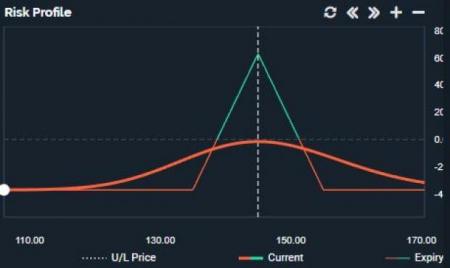Some readers have asked me about defining some spreads, so I’m going to spend the next few “Know Your Options” segments explaining some spread trades that might seem complicated but really aren’t.
Lets start with the “butterfly.”
A butterfly is a limited risk/limited reward trade that allows a trader to take a position on how volatile the underlying security will be. You can take either side. Buying the butterfly (if it’s at-the-money, or close) is a bet that the security won’t move very much before expiration. Selling the butterfly is a bet that the underlying will move outside the strike range – in either direction – before expiration.
First let’s define the trade. I’ll use calls first, but all the same principals apply to puts as well.
A long butterfly is the purchase of a call, the sale of two calls at a higher strike price and the purchase of one call at a strike an equal amount higher than that.
We call this set of trades the “long” side of the trade because it will involve a debit, even though we’ve bought and sold equal numbers of options.
Here’s an example in Disney (DIS), which is currently trading around $145/share and has very liquid options markets:
Buy one August 135 call, sell two August 145 calls and buy one August 155 call. These options have 36 days until expiration.
Current market prices are:
Bid Offer
135 Call 10.95 11.05
145 Call 4.30 4.40
155 Call 1.24 1.25
If we buy the offer on the 135 and 155 calls and sell the bid on two 145 calls, we’ll pay a total of $3.70. This premium that we’ve paid represents our maximum loss. The worst that can happen is that the trade is worth zero at expiration.
Now what now we want to happen? The profit/loss diagram looks like this:

You can see that our maximum profit ($6.70/spread) happens in Disney shares are trading exactly at $145 at expiration, our maximum loss occurs if the stock price is lower than $135 or higher than $155, and our breakevens are at $141.30 and $148.70.
So a long butterfly is essentially a bet that the shares of the underlying will be at or near a certain price at expiration.
If the middle strike of the butterfly is at-the-money, that means it’s a bet that the shares won’t move much between now and expiration.
Because options trades are zero-sum, a short butterfly is exactly the opposite – a bet that the underlying will move away from the current price and the max profit occurs if the shares move to (or through) the outside strikes.
I started with the butterfly because it illustrates an important concept that we’ll come back to again and again as we look at more complicated spreads.
Your maximum profit always occurs when the stock is exactly at your short strike at expiration. Some spreads will include a band or range of profit possibilities, but get used to the idea that you always want the stock to move away from long options and toward short options and you’ll be way ahead of the game.
One last tidbit. I discussed an at-the-money butterfly, but you can do this trade anywhere up or down the board.
Disney is scheduled to report quarterly earnings on August 6th. Perhaps you think they’re going to turn in a big beat and rally exactly 10% on the news. That would put the price right near $160/share. That’s a very specific target to pick for a stock on a specific day.
There are weekly options that expire on August 9th. (Weekly options tend to be a little bit less liquid than the “regular” monthly expirations. Notice these options have wider bid/ask spreads.)
Take a look at these prices:
Bid Offer
155 Call 1.21 1.32
160 Call 0.61 0.70
165 Call 0.34 0.40
You can buy that butterfly for only $0.50. If you’re correct and Disney is trading exactly at $160/share at expiration, the maximum profit is $9.50 per spread.
I’m not suggesting that particular trade. It’s an incredible longshot to pick an exact number like that, but it also pays off handsomely at 19:1.
I bring it up mostly as an example of the principle I mentioned earlier – that the maximum profit comes at the short strike.
Remember that.
Next Time: Condors
-Dave
The Walt Disney Company (NYSE:DIS): Free Stock Analysis Report
Original post
Zacks Investment Research
